How an Overlooked Visa Category Can Help Solve the US Labor Problem
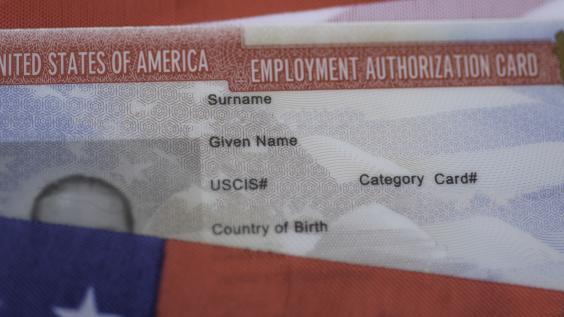
Table of Contents
Author(s)
Share this Publication
- Print This Publication
- Cite This Publication Copy Citation
Tony Payan, "How an Overlooked Visa Category Can Help Solve the US Labor Problem" (Houston: Rice University’s Baker Institute for Public Policy, April 4, 2023), https://doi.org/10.25613/YJ7K-XP30.
Introduction
This brief explores the potential of the TN visa — a category of work permits created by the North American Free Trade Agreement (NAFTA) in 1994 and preserved in its successor, the United States-Mexico-Canada Free Trade Agreement (USMCA) in 2020 — to aid in solving the growing structural problem of labor shortages in the United States, as well as the country’s deepening immigration crisis. Specifically, it outlines modifications that could be made to the visa’s eligibility parameters in 2026 — when the USMCA reaches its mandated review date — to provide an important, albeit partial, solution to two urgent issues facing the United States today: 1) key weaknesses in the country’s labor markets, including demographic shifts that are shrinking the U.S. workforce, and 2) the need to promote legal, orderly immigration to the United States.
Who Qualifies for the TN Visa?
NAFTA, which entered into effect on January 1, 1994, created a special economic relationship among the three countries of North America — Canada, the United States, and Mexico. Among its innovations was the Trade NAFTA (TN) visa, whose parameters and requirements are specified in Chapter 16 of the treaty.[1] The visa authorized Canadian and Mexican citizens to engage in a specified number of professional and business-related activities in the United States.[2] This visa category did not exist before 1994. Thus, NAFTA effectively created a new visa path to reflect a new North America, a continent united through a distinct commercial relationship.
During the renegotiations of the agreement in 2017-2020, there were some doubts over whether the TN visa category would survive, given then-President Donald Trump’s skepticism of both the trade accord and immigration altogether and his protectionist stance toward U.S. labor. But the visa category endured, and the USMCA contains the same provisions on TN visas, with no changes.[3]
However, the TN visa category has several limitations. First, it continues to be restricted to professions and business activities listed originally in NAFTA and today in the USMCA. This means that in practice, it is limited to 63 professions deemed eligible at the time of the NAFTA negotiations in the early 1990s and explicitly listed in the agreement. The Canadian and Mexican professionals permitted entry to “conduct business” or to “engage in a business activity at a professional level” in the United States qualify only under the activities specified in Annex 2 of Chapter 16 of the treaty (Table 1).
Table 1 — Professions Qualifying for the TN Visa Category Under the USMCA
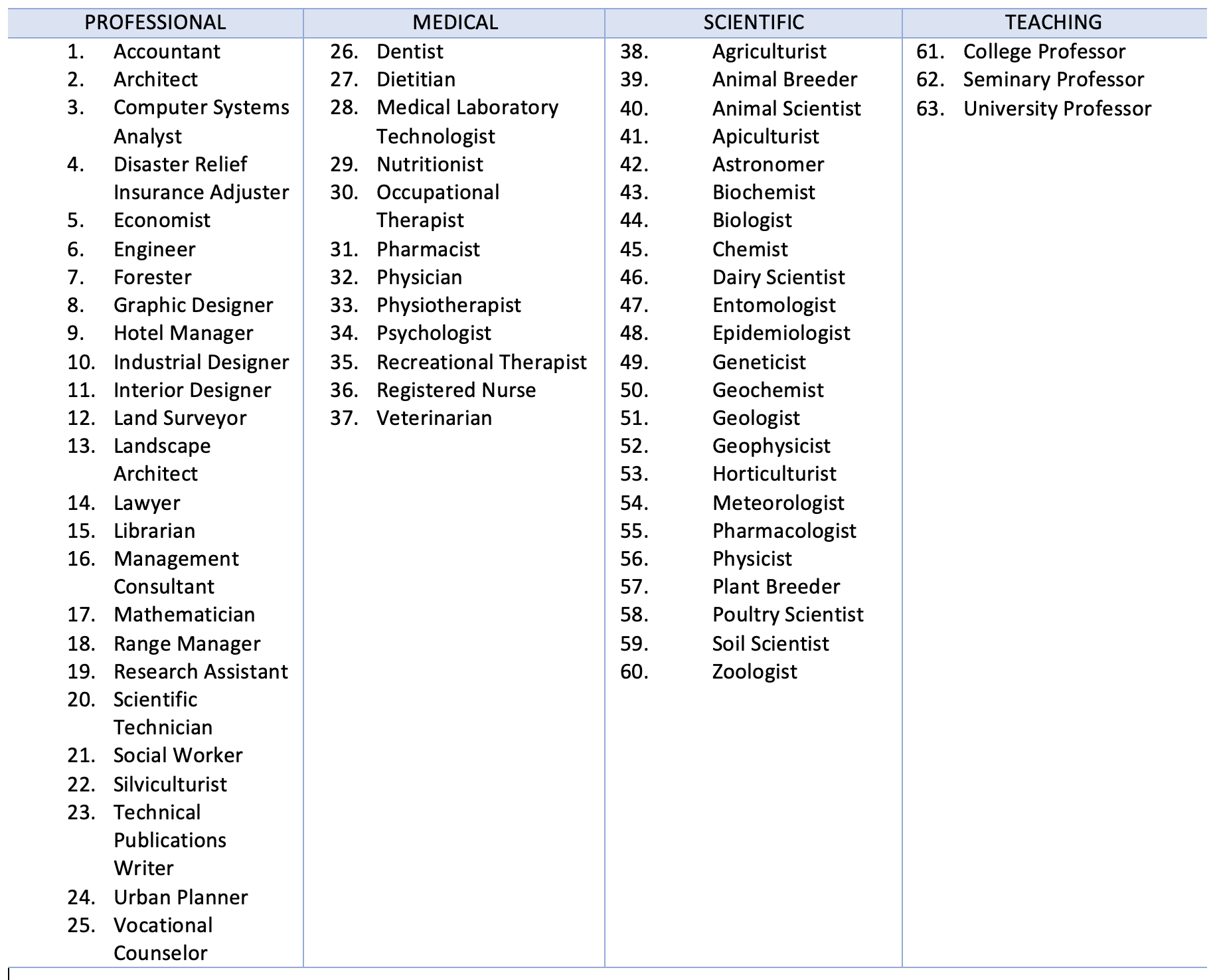
The list, which has not changed in nearly 30 years, despite the 2017-2020 negotiations, is outdated for the purpose of meeting U.S. labor needs. Some of the professions listed no longer exist or have evolved, and other key occupations have emerged in the 21st-century economy that are not covered by the agreement. Chrystia Freeland, deputy prime minister of Canada, argued in 2017 that “NAFTA’s Chapter 16, which addresses temporary entry for business people, should be reviewed and expanded to reflect the needs of businesses.” She further added that the NAFTA-led movement of professionals is “increasingly critical to companies’ ability to innovate across blended supply chains.”[4] Freeland’s criticism that the list of TN visa-eligible professions has remained unchanged and that the visa category is too restrictive because it is confined to just those professions specified is fair and further justified given the current debate on nearshoring manufacturing from Asia to North America.
Advantages of the TN Visa Over Other Work Visas
The TN visa carries certain advantages over other available work visas. First, it can be obtained quickly, especially by Canadians, although more Mexicans use it. Second, it has no annual cap, which other visas — such as the H-1B professional visa — do. Third, although it can be initially obtained for a 3-year period, like the H-1B visa, it is renewable indefinitely. (The H-1B visa is limited to two 3-year terms.) Finally, the TN visa is considerably less expensive to obtain than visas in other categories.
In addition, the TN visa has not drawn the kind of scrutiny and criticism that other visas have, such as H-1B — a professional visa that came under fire during the Trump administration, presumably because it allowed companies to hire foreigners instead of American workers and potentially underpay them.
Among the nonimmigrant work visas offered by the U.S., the TN visa is one of the most convenient to obtain. Its main disadvantage is that only Canadians and Mexicans can qualify for it — thereby reducing competition among applicants. More importantly, it has the potential to alleviate some of the key issues confronting labor markets in the United States today.
The success of the TN visa category is evident from the increase in its use by both Canadians and Mexicans over the past couple of decades. Figure 1 shows the number of TN visa admissions from 2004 to 2021. (A slump in admissions for both nationalities in 2020 and 2021 can be attributed to the COVID-19 pandemic.)
Figure 1 — Number of TN Visa Admissions to the United States by Nationality
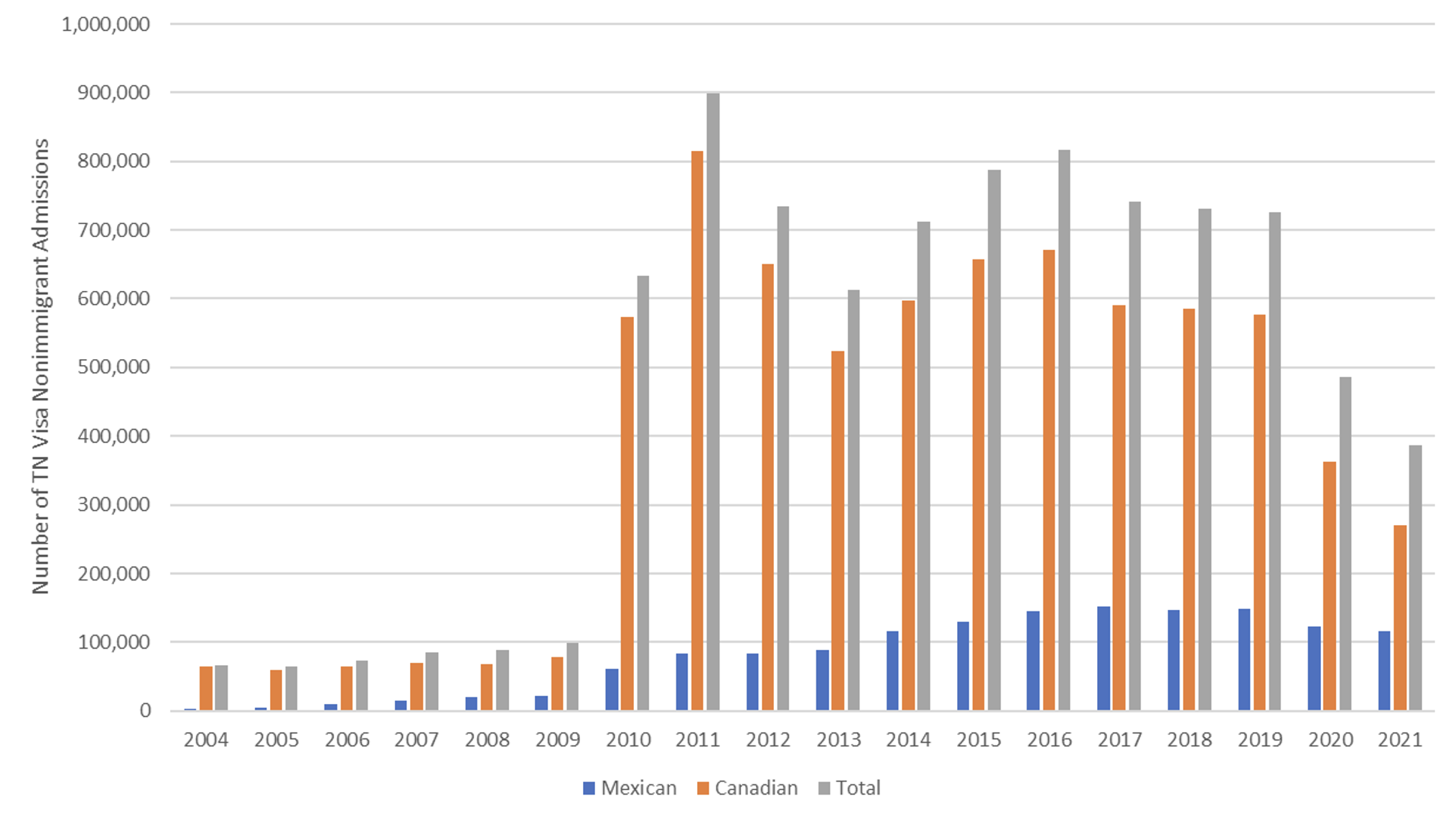
The U.S. Faces a Structural Labor Shortage
The United States is experiencing what some call a persistent labor shortage — something that has puzzled both the U.S. government and employers. In a speech delivered on November 30, 2022, Federal Reserve Board of Governors Chair Jerome H. Powell acknowledged that U.S. labor markets have a shortfall of 3.5 million workers. He listed several reasons for it — among them, the disruptions caused by the COVID-19 pandemic, an increase in retirements and retirees not returning to work, and demographic changes, including slower growth in the working-age population. These labor market shifts have resulted in what is beginning to look like a structural labor market shortage, according to Powell.[5]
Adding to these trends is a slump in legal migration to the United States, stemming from a slowdown in visa issuances during the Trump administration (2017-2021). According to the Department of State, the U.S. drastically reduced the number of immigrant visas issued under Trump (Figure 2), while the number of nonimmigrant visas issued also dropped substantially through 2020 (Figure 3).[6] This trend seems unlikely to end anytime soon, given the strength of the labor markets well into 2023.[7]
Figure 2 — Immigrant Visas Issued by the United States Between 1996 and 2022
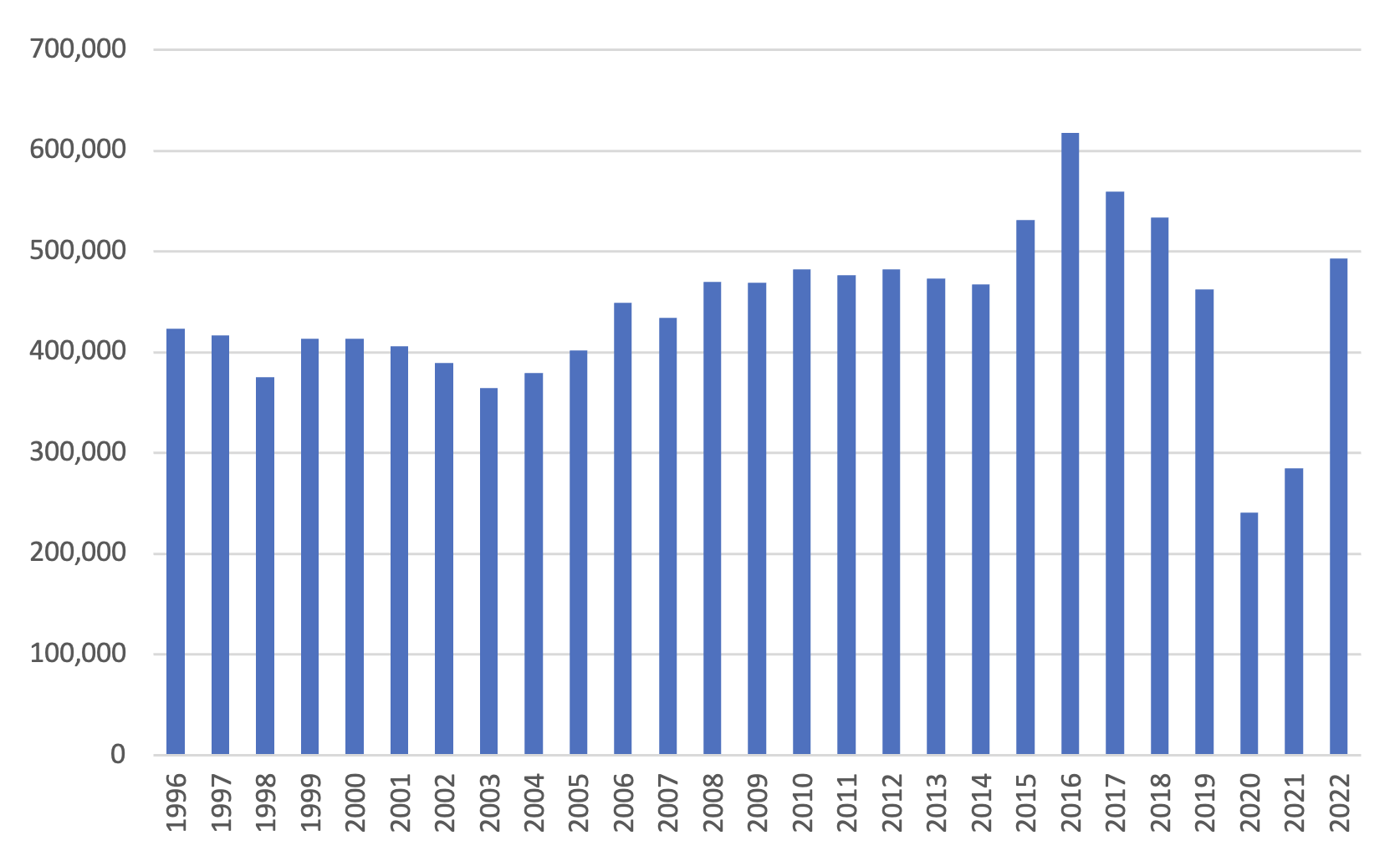
Figure 3 — Nonimmigrant Visas Issues by the United States Between 1996 and 2022
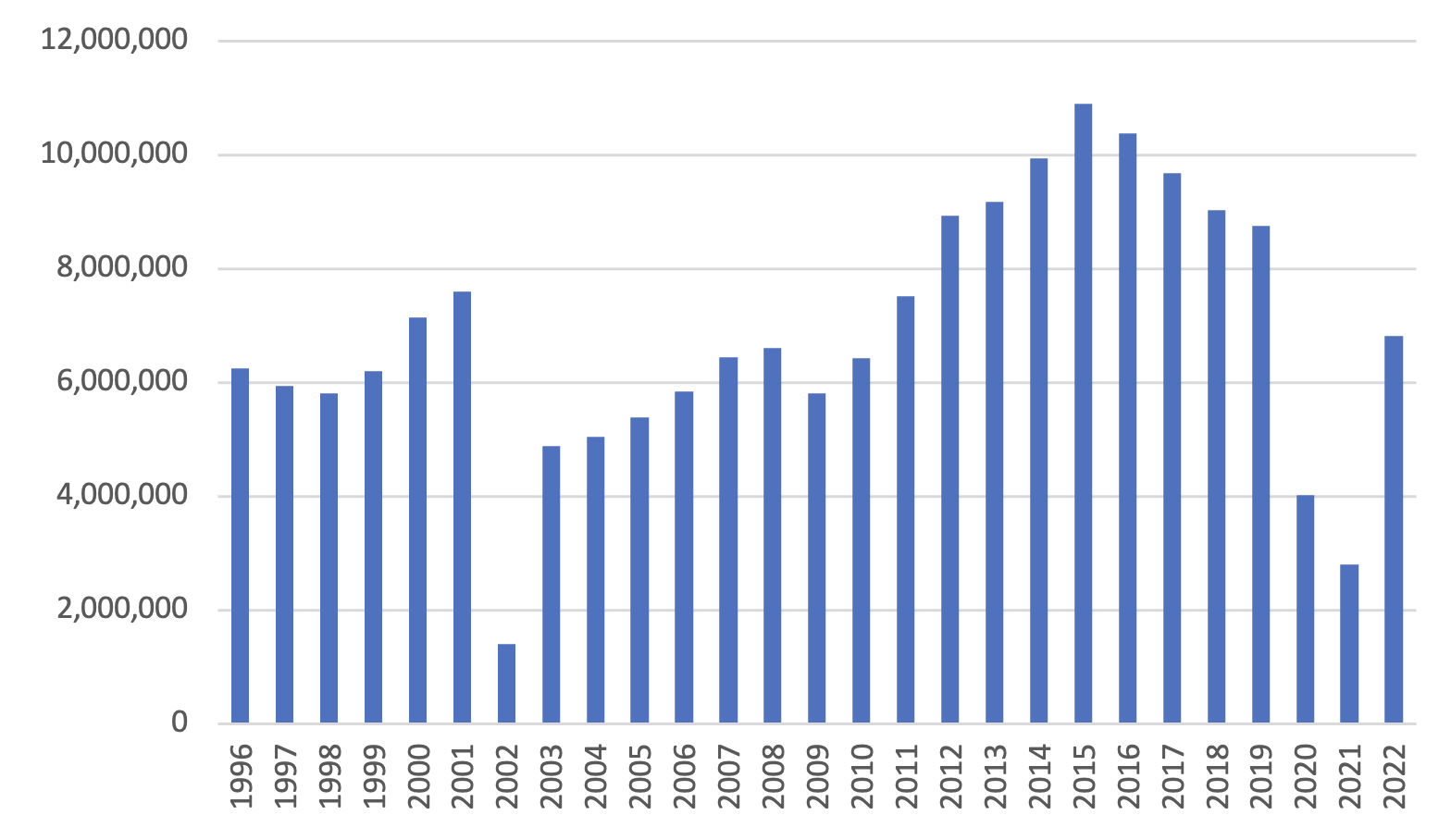
Note The numbers of nonimmigrant visas are substantially higher because they include the B-1 and B-2 traveler visas, which many individuals use to enter the U.S. for tourism, temporary business, or a combination of both.
Immigration is the fastest and most effective way to fill the gaps in U.S. labor markets. The advantage of immigration is that the U.S. government can pick and choose who is accepted based on the kinds of workers and skills that the economy seems to need. But most visas take a very long time to get, are expensive for employers, or are otherwise difficult or cumbersome for employers and their potential employees to obtain. Visas in higher preference categories take an especially long time to secure.
The TN visa can introduce much-needed flexibility to the process of obtaining nonimmigrant work visas. In doing so, it can help reduce labor shortages and even play a role in controlling illegal and disorderly migration. The following section outlines how.
One Way to Integrate North American Labor Markets: Expand or Modify the TN Visa Category
Thus far, the TN visa category has not been considered as a part of the needed response to U.S. labor market shortages. It would seem limited in its ability to reduce the shortfall, given that only Canadians and Mexicans can qualify, and it is restricted to a list of professions that is too short for a very large and diverse labor market. Nonetheless, the TN visa has distinct advantages, as discussed — for example, it’s easy to get, it’s relatively inexpensive, and it’s renewable indefinitely.
Moreover, the visa has a hidden advantage: It’s already indexed to employment levels in the United States. Each applicant must first obtain a job offer and then request the TN category work permit either at the border (Canadians) or at a consulate (Mexicans). This means that the visa has built-in flexibility — when the economy is not performing well, the job offers drop, lowering the number of visas issued, and when the economy is doing well, the number of visas issued increases with the job offers. No other visa has this kind of deep flexibility.
One way to lean on the TN visa category to fill the labor market gaps and manage Mexican workers’ participation in the U.S. employment scene is to expand the list of qualifying professions. Canadian and Mexican professionals can be incentivized to use this visa in certain sectors of the labor market, depending on how the U.S. government interprets the qualifications and educational requirements of the professions listed in Chapter 16. Additional professions can be added to the list, along with new subcategories of professions that qualify. For example, the teaching category could be expanded to include jobs relating to all levels and types of education, training, and re-skilling.
The best way to take advantage of the TN visa category, however, would be for the USMCA parties to create a negative list of qualifying professions — that is, not list the professions that qualify but instead specify those that do not, thereby freeing unlisted sectors to use TN visas as needed to meet the demands of U.S. labor markets. Such a list could include intelligence agents, police, or any government job, for example, leaving employers and workers in other sectors free to find each other.
This, of course, would require that the USMCA itself be modified. This was hard to do with NAFTA, as it would have meant opening up negotiations all over again, throwing the entire agreement into question. However, the USMCA does provide a mechanism to periodically make modifications to the agreement, including to Chapter 16.
An Opportunity to Expand or Modify the USMCA Arrives in 2026
Some critics of the USMCA felt that its sunset clause, which President Trump insisted on adding, introduced too much uncertainty to the agreement. But it may turn out to be an excellent opportunity to ensure that the treaty remains modern, flexible, and relevant. It also provides an opportunity to review Chapter 16 and expand — or preferably modify — the agreement to promote legal and orderly labor market integration in North America. Article 34.7 of the treaty states that “On the sixth anniversary of the entry into force of this Agreement, the Commission shall meet to conduct a ‘joint review’ of the operation of this Agreement, review any recommendations of action submitted by a Party, and decide on any appropriate actions.”
That anniversary is July 1, 2026. It is therefore imperative to begin conversations on how Chapter 16 can be changed to legally and orderly integrate labor markets among all three countries. Of course, this change would not solve the legal status of the undocumented resident population in the United States, but it would open a new venue for orderly and legal labor market integration into the future. Finally, although the visa is admittedly only for Canadians and Mexicans, even having access to just Mexico’s labor surplus would be advantageous for the United States. Similarly, broader access to the U.S. labor markets would be beneficial for Mexican citizens.
Conclusion
The TN visa category is not a magic bullet. Rarely in public policy does a single action solve a problem in its entirety, much less several important issues at hand. But modifying Chapter 16 of the USMCA can 1) help the U.S. meet its labor demands, 2) expand legal and orderly labor market integration in North America (especially with Mexico, a major and growing source of undocumented migration to the United States once again), and 3) assuage some concerns about demographic shifts in the United States that directly impact the economy.
Over the next year, all three of the USMCA parties will be at work crafting potential modifications to the agreement. Changing the parameters of the TN visa should be one of them.
Endnotes
[1] North American Free Trade Agreement (NAFTA), Chapter 16: Temporary Entry for Business Persons, https://bit.ly/40eiyj3.
[2] Spouses and children of TN visa-holders could also obtain a trade dependent (TD) visa.
[3] “TN NAFTA Professionals,” Temporary Workers, U.S. Citizenship and Immigration Services, accessed March 16, 2023, http://bit.ly/3TIDsUP.
[4] Kelly Cryderman, “Tech Sector Urges Revisions to Visa Rules in NAFTA Talks,” Global and Mail, September 11, 2017, http://bit.ly/3TE4gG1.
[5] Jerome H. Powell, “Inflation and Labor Market” (speech), Federal Reserve, November 30, 2022, http://bit.ly/3FQW5Aq.
[6] Alex Nowrasteh, “President Trump Reduced Legal Immigration. He Did Not Reduce Illegal Immigration” (blog), CATO Institute, January 20, 2021, https://bit.ly/3LXf2oG.
[7] Bureau of Labor Statistics, “Employment, Hours, and Earnings from the Current Employment Statistics Survey,” 2023, http://bit.ly/3FRGvo1.
This material may be quoted or reproduced without prior permission, provided appropriate credit is given to the author and Rice University’s Baker Institute for Public Policy. The views expressed herein are those of the individual author(s), and do not necessarily represent the views of Rice University’s Baker Institute for Public Policy.



